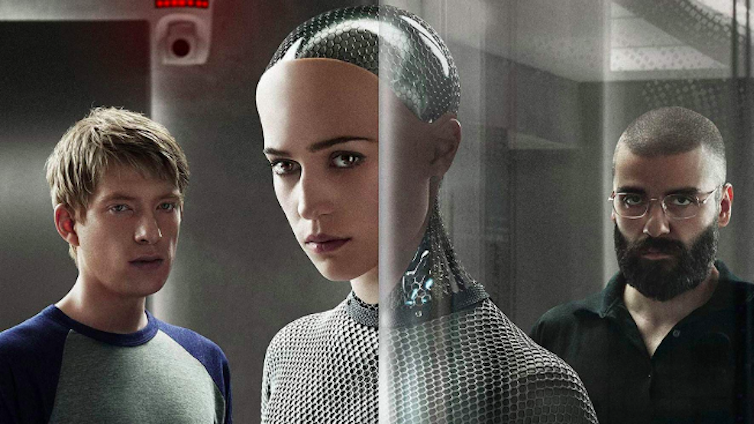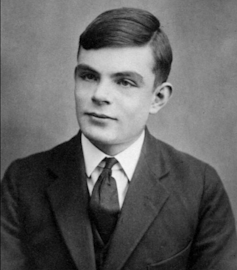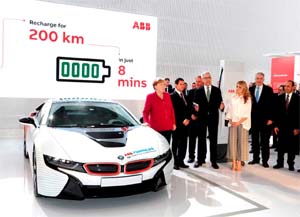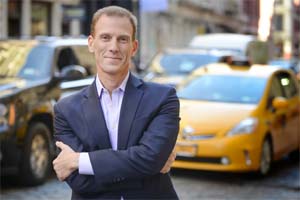
Content
Welcome to the Club of Amsterdam Journal.
The Future Now Show about Peferred Future with Glen Hiemstra
“At Futurist.com our primary emphasis has always been on creating the “preferred future.” Thus, we have developed methods to push alternative future scenarios toward a preferred scenario for the organization, the community, or whatever enterprise is planning for its future. This approach has been applied to community futures, to transportation, to future libraries, and to information technology organizations.” – Glen Hiemstra
Felix B Bopp, Founder & Chairman
Ethics of AI: how should we treat rational, sentient robots – if they existed?

By Hugh McLachlan, Professor Emeritus of Applied Philosophy, Glasgow Caledonian University

Imagine a world where humans co-existed with beings who, like us, had minds, thoughts, feelings, self-conscious awareness and the capacity to perform purposeful actions – but, unlike us, these beings had artificial mechanical bodies that could be switched on and off.
That brave new world would throw up many issues as we came to terms with our robot counterparts as part and parcel of everyday life. How should we behave towards them? What moral duties would we have? What moral rights would such non-human persons have? Would it be morally permissible to try to thwart their emergence? Or would we have a duty to promote and foster their existence?
Intriguing ethical questions such as these are raised in Ian McEwan’s recent novel, Machines Like Me, in which Alan Turing lives a long successful life and explosively propels the development of artificial intelligence (AI) that leads to the creation of “a manufactured human with plausible intelligence and looks, believable motion and shifts of expression”.
As intellectual speculation, to consider the ethics of the treatment of rational, sentient machines is interesting. But two common arguments might suggest that the matter has no practical relevance and any ethical questions need not be taken seriously.
The first is that such artificial people could not possibly exist. The second, often raised in the abortion debate, is that only persons who have living and independently viable human bodies are due moral respect and are worthy of moral consideration. As we shall see, these arguments are debatable.
Mind, matter and emergent properties
We might suppose that mental phenomena – consciousness, thoughts, feelings and so on, are somehow different from the stuff that constitutes computers and other machines manufactured by humans. And we might suppose that material brains and material machines are fundamentally different from conscious minds. But whether or not such suppositions are true – and I think that they are – it does not follow that sentient, consciously aware, artificially produced people are not possible.
The French sociologist Emile Durkheim has argued very convincingly that we should beware of simplistic arguments in social science. Social phenomena, such as language, could not exist without the interaction of individual human beings with their particular psychological and biological features. But it does not follow that the resultant social phenomena – or “emergent properties” – can be completely and correctly explained solely in terms of these features.
The same point about the possibility of emergent properties applies to all sciences. There could not be, for instance, computers of the sort I am now working at without the pieces of plastic, wires, silicon chips and so forth that make up the machine. Still, the operations of a computer cannot be explained solely in terms of the features of these individual components. Once these components are combined and interact in particular ways with electricity, a phenomenon of a new sort emerges: a computer. Similarly, once computers are combined and interact in particular ways, the internet is created. But clearly, the internet is a different sort of phenomenon from a tangible, physical computer.

In a similar way, we need not suppose that minds are reducible to brains, molecules, atoms or any other physical elements that are required for them to function. They might be entities of a different sort that emerge from particular interactions and combinations of them.
There’s no obvious logical reason why conscious awareness of the sort that human beings possess – the capacity to think and make decisions – could not appear in a human machine some day. Whether it is physically possible and, therefore likely to actually happen, is open to debate.
Do machines deserve our consideration?
It doesn’t seem controversial to say that we shouldn’t slander dead people or want only destroy the planet so that future generations of unborn people are unable to enjoy it as we have. Both groups are due moral respect and consideration. They should be regarded as potential objects of our moral duties and potential recipients of our benevolence.
But the dead and the yet to be born do not have viable bodies of any sort – whether natural or artificial. To deny conscious persons moral respect and consideration on the grounds that they had artificial rather than natural bodies would seem to be arbitrary and whimsical. It would require a justification, and it is not obvious what that might be.
One day, maybe sooner than we think, a consideration of the ethics of the treatment of rational, sentient machines might turn out to be more than an abstract academic exercise.
This article is republished from The Conversation under a Creative Commons license.
Permaculture 101

Geoff Lawton is a world renowned permaculture consultant, designer and teacher. He first took his Permaculture Design Certificate (PDC) Course in 1983 with Bill Mollison, widely considered the “father of permaculture.” Geoff has undertaken thousands of jobs teaching, consulting, designing, administering and implementing, in 6 continents and over 50 countries around the world. Clients have included private individuals, groups, communities, governments, aid organizations, non-government organisations and multinational companies, including:
- consultancy in the environmentally green, Masdar City in the United Arab Emirates
- development work from the Greening the Desert projects in Jordan
- rehydration strategies in the deserts of Hadramaut, Yemen
- housing projects for the Kurds in Iraq after the war, rebuilding an entire village with 53 straw bale houses
In 1996 he was accredited with the Permaculture Community Services Award by the permaculture movement for services in Australia and around the world.
He has currently educated over 15,000 students in Permaculture worldwide. These include graduates of the Permaculture Design Certificate (PDC) Course and courses focused on the practical design of sustainable soil, water, plant, animal, energy, structures, legal and economic systems.
Geoff has established permaculture demonstration sites that function as education centres in all the world’s major climates — information on the success of these systems is networked through www.permacultureglobal.org. Geoff established the Permaculture Research Institute and the www.permaculturenews.org website to network mainframe information worldwide.
The Future Now Show
Shape the future now, where near-future impact counts and visions and strategies for preferred futures start. – Club of Amsterdam
Do we rise above global challenges? Or do we succumb to them? The Future Now Show explores how we can shape our future now – where near-future impact counts. We showcase strategies and solutions that create futures that work.
Every month we roam through current events, discoveries, and challenges – sparking discussion about the connection between today and the futures we’re making – and what we need, from strategy to vision – to make the best ones.
July / August 2019
with
Glen Hiemstra
At Futurist.com our primary emphasis has always been on creating the “preferred future.” Thus, we have developed methods to push alternative future scenarios toward a preferred scenario for the organization, the community, or whatever enterprise is planning for its future. This approach has been applied to community futures, to transportation, to future libraries, and to information technology organizations.” – Glen Hiemstra
The Future Now Show
Credits

Holographic circus

The Challenge
The Roncalli circus, founded in Germany in 1976 wanted to develop the traditional circus experience in an imaginative, creative way. Roncalli wanted to create 3D holographic images from bright, reliable, long-lasting projectors to fill the circus arena measuring 32 meters wide and 5 meters deep with 360° visibility for the entire audience.
The Solution
Roncalli’s agency TAG/TRAUM in cooperation with Bluebox selected Optoma as the best solution for this project and installed 11 ZU850 laser projectors for a mesmerizing holographic experience.
Birger Wunderlich at Bluebox stated: “We have been using Optoma projectors for 6 years and have consistently had a very positive experience in price, performance and reliability. We needed a high contrast projector with great colors for the 3D effect and the ZU850’s 2,000,000:1 contrast is perfect for this project.”
Boasting superior color performance and 360° projection capability, Optoma’s ZU850 model with innovative MultiColor laser technology has assisted in creating a phenomenal experience for Roncalli circus visitors.
Thousands of visitors now enjoy a modern, entertaining twist on the circus experience. With 360° projection of horses galloping around the arena and elephants doing head stands, the Roncalli circus experience is not one to miss.
The installation was completed using 11 BX-CTA03 long throw lenses allowing the ZU850 projectors to be positioned further away for ultimate flexibility.
The Results
Optoma’s ZU850 projectors bring the Roncalli circus to life, thrilling audiences all over Germany and Austria with entertaining holographic footage.
Birger Wunderlich at Bluebox said: “We chose to install the Optoma ZU850 projectors because we needed a consistent light output over the duration of the installation and Optoma has delivered us this on an exceptional level.”
Janine Kunze, an actress from Germany stated: “I thought the hologram at the beginning was really great. You actually remember the circus, especially Roncalli, with horses and dogs, they always used to be part of it, and I think they really included it well. Also, in the beginning when they told the story in a new kind of way.”
Visitors of the Roncalli circus are left mesmerized and inspired by the effects produced by the Optoma projectors.
Katja Burkard, a TV Presenter from Germany stated: “I find the hologram very contemporary – especially the fact that there are no animals involved is very good.”
News about the Future

Carbon-neutral fuel made from sunlight and air
Carbon-neutral fuels are crucial for making aviation and maritime transport sustainable. ETH researchers have developed a solar plant to produce synthetic liquid fuels that release as much CO2 during their combustion as previously extracted from the air for their production. CO2 and water are extracted directly from ambient air and split using solar energy. This process yields syngas, a mixture of hydrogen and carbon monoxide, which is subsequently processed into kerosene, methanol or other hydrocarbons. These drop-in fuels are ready for use in the existing global transport infrastructure.
Aldo Steinfeld, Professor of Renewable Energy Carriers at ETH Zurich, and his research group developed the technology. “This plant proves that carbon-neutral hydrocarbon fuels can be made from sunlight and air under real field conditions,” he explained. “The thermochemical process utilises the entire solar spectrum and proceeds at high temperatures, enabling fast reactions and high efficiency.” The research plant at the heart of Zurich advances ETH’s research towards sustainable fuels.

Solar Methanol Islands
A team of researchers from Norway and Switzerland has put forward a proposal for ‘Solar Methanol Islands’ that convert atmospheric carbon dioxide to fuel. The islands would have to be clustered together to create large-scale facilities. If enough of these facilities were built, they could eventually offset the total global emissions from fossil fuels and thus help protect our climate from global warming.
Large-scale, marine-based artificial islands of these solar farms could eventually yield zero net CO2 emissions – if enough of them are built. The so-called solar methanol islands would need to be placed in ocean areas where wave heights are less than seven meters tall and there is a low risk of hurricanes. Further, water depths must be less than 600 meters to properly moor the islands.
Therefore, the most suitable locations are shorelines along the equator with plenty of sunshine and relatively small waves, for instance, Indonesia, northern Australia, and Brazil.
They calculate that a cluster of 70 islands could potentially produce up to 1.75 tonnes of methanol per hour – which means 170,000 clusters need to be constructed to offset the emissions from long-haul transport. Moreover, they suggest using a mere 1.5 per cent of the world’s oceans for solar methanol farms could offset global fossil fuel emissions altogether.
All-electric aircraft Alice

The Eviation Alice is an electric aircraft under development by Eviation Aircraft of Israel. Designed to take 9 passengers up to 540–650 nmi (1,000–1,200 km) at a cruise speed of 240 kn (440 km/h). Alice will redefine regional transportation as an all-electric aircraft.
Alice uses distributed propulsion with one main pusher propeller at the tail and two pusher propellers at the wingtips to reduce drag, create redundancy, and improve efficiency.
Two versions of the Alice are planned. The initial model will be intended for air taxi operations, with energy stored in a lithium-ion battery, Eviation is building a prototype scheduled to fly in early 2019 and aims to certify it under the FAR Part 23 for IFR and known icing conditions. The second model will be an extended-range ER executive aircraft available by 2023 for $2.9 million, with a more powerful aluminum-air battery with a lithium-polymer buffer, a cabin pressurised to 1,200 m (4,000 ft) at FL 280, G5000 avionics, a 444 km/h (240 kn) cruise and 1,367 km (738 nmi) range.
With 260 Wh/kg cells, the 900 kWh battery capacity (3,460 kg, 7,630 lb) gives the design a range of 540–650 nmi (1,000–1,200 km) at 240 knots and 10,000 ft (3,048 m). This is anticipated to increase as battery technology improves. The batteries have been tested to more than 1,000 cycles, equivalent to 3,000 flight hours, and will then require replacement at a cost of $250,000 – half of the direct operating cost, similar to a piston engine overhaul. Based on U.S. industrial electricity prices, the direct operating cost with nine passengers and two crew, flying at 240 kn (440 km/h), will be $200 per hour, which compares to $600–1,000 per hour for existing aircraft of similar purchase price, for operations on routes under 500 nmi (930 km). This includes piston- and turboprop-powered Cessna 402s, Pilatus PC-12 and Beechcraft King Airs. Eviation notes 45% of air routes fall within its 565 nm (1,050 km) range at 260 kt (482 km/h), or 55% of airline flights according to Flightglobal’s Cirium data.
The electric drivetrain will have a higher voltage than current electrical systems. The 300-kW and 400-kW chargers will recharge after one hour of flight time in half an hour. Three 260 kW (350 hp) motors drive propellers mounted on the wingtips, located in the vortices to improve efficiency, and mounted on the tail. The unpressurized aircraft will have a flat lower fuselage. The Italian company Magnaghi Aeronautica will supply the landing gear and has already produced the gear for the similarly sized Piaggio P.180 Avanti. It will be built with existing technology, including a composite airframe, distributed propulsion with Siemens electric engines and Honeywell flight control systems, including automatic landing. Mobile charging stations will give one hour of flight per half-hour of charge. At 3,700kg (8,200lb), the battery accounts for 60% of the aircraft take-off weight.
The first all-electric zero-emission regional airplane.
The future is electric! Eviation will debut the Alice at the Paris Air Show in June 2019.
Recommended Book

Mars: Our Future on the Red Planet
by Leonard David, Ron Howard (Foreword)
An inspiring exploration of the establishment of humans on Mars — tying into the National Geographic television documentary series Mars.
The next frontier in space exploration is Mars, the Red Planet — and human habitation of Mars isn’t much farther off. In October 2015, NASA declared Mars “an achievable goal”; that same season, Ridley Scott and Matt Damon’s The Martian drew crowds into theaters, grossing over $200 million.
Now the National Geographic Channel fast forwards years ahead with Mars, a six-part series documenting and dramatizing the next twenty-five years as humans land on and learn to live on Mars. Following on the visionary success of Buzz Aldrin’s Mission to Mars and the visual glory of Marc Kaufman’s Mars Up Close, this companion book to the Nat Geo series shows the science behind the mission and the challenges awaiting those brave individuals.
The book combines science, technology, and storytelling, offering what only National Geographic can create. Clear scientific explanations make the Mars experience real and provide amazing visuals to savor and return to again and again.
200 kilometers in 8 minutes: ABB’s fast chargers power the e-mobility revolution
World’s fastest e-vehicle charger strengthens ABB’s leadership in sustainable mobility
Zurich, Switzerland | 2018-06-08
What started as a small start-up in one of ABB’s business units almost a decade ago is now an integral part of the company’s innovative push for sustainable mobility. One innovation after another is coming from ABB developments in electric-vehicle (EV) chargers.
Today, ABB’s breakthrough e-mobility technologies are front-page news. German Chancellor Angela Merkel and Mexican President Enrique Pena Nieto visited the ABB exhibit at the Hanover Fair to see the newly launched Terra High Power fast-charging station and hear about its impact on sustainable transport from ABB CEO Ulrich Spiesshofer. The Terra HP is the world’s fastest EV-charger, adding up to 200 kilometers of range to an electric vehicle in just eight minutes. With the number of electric vehicles on the road rising, the global demand for powerful and energy efficient vehicle charging stations is ever increasing.

ABB EV-chargers, like the Terra High Power charger, are the driving force behind the efforts of nations to reach sustainability targets and charges have become a critical part of sustainability policies. With more than 7,000 DC fast charging stations installed in 60 countries, ABB is a global leader in that segment.
The technology behind e-mobility is truly coming of age, which is also shown in ABB’s partnership with the ABB FIA Formula E Championship. ABB is bringing its name, innovation and technology leadership to the first fully electric motor sport series. The ABB FIA Formula E Championship perfectly supports ABB’s belief that we can run the world without consuming the earth. The series’ next race will be in Zurich on June 10.

ABB FIA Formula E Championship race driver Sébastien Buemi drives through Zurich
The ascendance of sustainable mobility and the charging infrastructure required to keep electric vehicles moving is evident by the increasing number of ABB EV charging projects around the world.
German energy supplier EnBW alone has 185 EV fast chargers on German motorways and in April, ABB was selected to supply its Terra HP charging stations as part of the biggest electric vehicle infrastructure project to date in the United States. The chargers were selected for deployment by Electrify America, which plans to place hundreds of charging stations within and around 17 metropolitan areas and along multiple nationwide highway corridors.
The chargers are an important element, for example, in Iceland’s ambitious plan to increase the adoption of renewable energy. While fossil fuels still account for 20 percent of overall energy usage, the Icelandic government has put in place a state-financed incentive program to increase the use of electric vehicles.
It is already having an impact — today there are more than 6,000 e-cars, compared to a scant 90 in 2014. To power these e-cars, more than 20 ABB fast charging stations have been installed along Iceland’s famous Route 1, the 1,300+ kilometer road that’s the country’s main highway and its logistical backbone.
ABB has also delivered six 350kW fast chargers in Switzerland, the first with liquid-cooled cables in Europe, as part of the IONITY initiative to open highway “fuel” stations of the future at 400 sites across Europe by mid-2019. IONITY is a company joint venture of BMW Group, Daimler AG, Ford Motor Company and VW Group, with Audi and Porsche. This first site in Switzerland was planned, engineered and built by Alpiq, a leading energy company in Switzerland and the largest energy service provider with focus on European markets.
ABB Ability™ technology guarantees that the chargers are operational 24/7. Remote digital connectivity enables continuous monitoring of the device from any location. This gives access to data in real time for the remote monitoring and proactive control of the operational and technical status of the charging stations.
ABB’s charging technologies for electric cars, buses and trucks, as well as solutions for the electrification of ships, railways and cableways, firmly establishes it as a global champion in e-mobility and sustainable transportation. It is playing a crucial role in the fight against climate change as e-mobility begins to replace fossil-fuel-powered vehicles, which contribute to global warming.
ABB’s fast-chargers help to pave the way for a quick adoption of electric vehicles, which are increasingly becoming more attractive and less expensive to buy and maintain. As policy makers across the world promote sustainable transport solutions ABB will continue to be at the forefront to develop a greener future for all.
Climate Change Success Story: Nutri2Cycle

Smarter farming to cut pollution and improve efficiency
The NUTRI2CYCLE project recognizes Europe’s need to tackle the current nutrient flow gaps in European agro-ecosystems in order to decrease environmental pollution, safeguard the quality of life and improve EU independence for energy and nutrients.
A genuine approach to close nutrient loops
Nutri2Cycle will help closing nutrient loops with a genuine approach that will consist of:
- Identifying the most efficient types of farm systems in Europe using a common methodology.
- Defining indicators to monitor and demonstrate the environmental advantages of more efficient, closed nutrient loops in a comprehensive way.
- Establishing innovative business cases at pilot scale (12-16 pilots) that will act as a light-house example for effective out-scaling.
Objectives
From farmers to end-users: targeting the whole value chain
Nutri2Cycle will interact with all actors influencing nutrient cycles to:
- Create more efficient and sustainable farm business models for nutrient recovery and recycling.
- Spread the results at regional, national and European level throughout a comprehensive network of regional operational groups, National Task Forces and European stakeholders.
- Assess how the products obtained through the identified business models can aim for labelling and reach end-users.
- Provide scientific support on effective regulatory frameworks to reduce emissions and increase self-reliance of Europe for food, energy and nutrients in the next century.
Focus
The research of Nutri2Cycle will focus on three pillars:
- agro-processing
- animal husbandry
- plant processing
The recovery of nitrogen and phosphorus in farms can be significantly improved by creating better synergies between animal breeding and crop production. These improvements will facilitate the return of carbon to soil and reduce greenhouse gas emissions, which could be combined with the production of energy for self-consumption on-farm.

Futurist Portrait: Jamie Metzl

Jamie Metzl is a technology futurist and geopolitical expert, novelist, entrepreneur, media commentator, and Senior Fellow of the Atlantic Council. In February 2019, he was appointed to the World Health Organization expert advisory committee on developing global standards for the governance and oversight of human genome editing. Jamie previously served in the U.S. National Security Council, State Department, Senate Foreign Relations Committee and as a Human Rights Officer for the United Nations in Cambodia. He is a former Partner of a New York-based global investment firm, serves on the Advisory Council to Walmart’s Future of Retail Policy Lab, is a faculty member for Singularity University’s Exponential Medicine conference, was Chief Strategy Officer for a biotechnology company, and ran unsuccessfully for the U.S. House of Representatives from Missouri’s Fifth Congressional District in Kansas City in 2004. Jamie has served as an election monitor in Afghanistan and the Philippines, advised the government of North Korea on the establishment of Special Economic Zones, and is the Honorary Ambassador to North America of the Korean Ministry of Trade, Industry, and Energy.
Jamie appears regularly on national and international media discussing Asian economic and political issues and his syndicated columns and other writing on Asian affairs, genetics, virtual reality, and other topics are featured regularly in publications around the world. He is the author of a history of the Cambodian genocide, the historical novel The Depths of the Sea, and the genetics thrillers Genesis Code and Eternal Sonata. His non-fiction book Hacking Darwin: Genetic Revolution and the Future of Humanity, published by Sourcebooks, can be purchased here.
A founder and Co-Chair of the national security organization Partnership for a Secure America, Jamie is a board member of the International Center for Transitional Justice and the American University in Mongolia, and a member of the Advisory Board of the Brandeis International Center for Ethics, Justice, and Public Life. He is a member of the Council on Foreign Relations is a former White House Fellow and Aspen Institute Crown Fellow. Jamie holds a Ph.D. in Asian history from Oxford, a JD from Harvard Law School, and is a magna cum laude, Phi Beta Kappa






Customer Reviews
Thanks for submitting your comment!